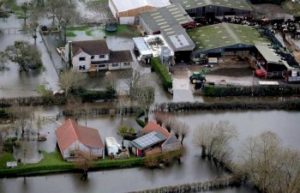by C. Xing & F. Liu, Jan 2023 in InnovativeGeoscience
The devastating flood of 2020 along the Yangtze River serves as a painful reminder of the 1991 East China’s largest flood. The latter event profoundly impacted the Yangtze-Huaihe River basins (YHRBs), causing extensive damage to both human lives and property1. The flood engulfed numerous villages and cities across seven provinces in East China, affecting over 15,000,000 hectares of farmland and approximately 100 million people. In response, millions of individuals in Anhui and Jiangsu provinces were forced to evacuate, with some seeking refuge on the banks of the Huaihe River. Gaining a comprehensive understanding of the contributing factors to this historically significant flood will enhance our ability to predict the East Asian summer monsoon and mitigate related climate disasters. Over the past three decades, this pursuit has been a persistent challenge1,2,3.
The 1991 East China flood was attributed to prominent intraseasonal oscillations, as evidenced by three episodes of heavy rain occurring from mid-May to mid-July over the YHRBs2, primarily linked to the persistent Meiyu front during early July1. The stable western Pacific subtropical high (WPSH), which plays a crucial role in influencing the East Asian monsoon by altering the convergence of southeasterly and southwesterly, provided substantial support for the prolonged existence of the Meiyu front in 19911; However, the reason behind the prolonged stability of the WPSH during that specific period remains a mystery.
No internal climate variability modes were reported to be in their most flood-favorable conditions during 1991, and the effect of external forcing on this flood disaster was not taken into consideration at all. Half a month before the flood, the Mount Pinatubo (located at 120.4ºE, 15.1ºN) in Luzon, the Philippines, explosively erupted on June 15th, 1991, which later is known as one of the strongest volcanic eruption in the past century. This eruption released approximately 20 Tg of SO2 into the tropical stratosphere4, which can form stratospheric aerosol that impact the global radiative balance. The stratospheric volcanic aerosol acts as a major forcing on the climate by cooling the global surface and slowing down the water cycle on annual to decadal timescales5. However, it remains unclear whether explosive volcanic eruptions have short-term impacts on the climate, particularly on the intraseasonal timescale.
…
by P. Homewood, Apr 18, 2023 in NotaLotofPeopleKnowThat
We’ve all heard the terminology. An extreme event happens — a flood or heat wave — and soon after it is characterized as a “1,000-year event” (or it doesn’t have to be 1,000, it could be any number). This week I watched one of the world’s most visible climate scientists, Michael E. Mann, go on national TV and in process show that he had no idea what the concept actually means.
Let’s start by correcting that climate scientist who expressed a popular misconception (about which climate scientists should know better). A 1,000-year flood does not refer to a level of flooding that comes around every 1,000 years.
…
…
by P. Gosselin, July 17, 2021 in WUWT/NTZ
Harsh criticism of German authorities failing to act is mounting in the aftermath of the recent deadly floods.
Germany’s New Orleans
Many of the over one hundred people died in the recent flood disaster in Central Western Germany could have been prevented – had the responsible institutions heeded the warnings that had been already issued days in advance by the weather services. Authorities had been warned days early, yet they did nothing to prepare to evacuate and mobilize resources. The media did nothing to warn.
Veteran meteorologist: “much could have been prevented”
Swiss meteorologist Jörg Kachelmann told in a PULS 24 interview that “much of it could have been prevented” and that “people could have been warned”.
“The rainfall could not have been prevented” but the authorities and the “media could have warned the population.” The veteran Swiss meteorologist is surprised by the “surprise of the authorities” and says “people could have been evacuated or at least items moved to higher floors”.
“Let people drown” as “they broadcast shit”
Kachelman also commented to Germany’s leading national daily, Bild: “It hurts when the very people who would have the resources to accompany such a weather situation 24/7 do nothing to save lives. But they broadcast shit and let people drown.”
Unpreparedness becoming a German habit
…
by J. Delingpole, February 19, 2020 in ClimateChangeDispatch
Boris Johnson’s Greenest Government Evah has come up with a brilliant new excuse to duck its responsibilities for all the floods now swamping parts of Britain: climate change ate our homework.
From Hereford to Shrewsbury and South Wales to North Yorkshire, swathes of Britain are underwater thanks to flooding in the aftermath of Storm Dennis, which so far has claimed five lives.
There are currently more than 400 flood warnings around Britain, with more heavy rain forecast to come.
But the government has effectively absolved itself of responsibility by pinning the blame on ‘climate change.’
Environment Secretary George ‘Useless’ Eustice has said in an interview with LBC radio that the scale of the flooding is due to the ‘nature of climate change.’
by B. Lynn Ingram, January 1, 2013
43-day storm that began in December 1861 put central and southern California underwater for up to six months, and it could happen again
Geologic evidence shows that truly massive floods, caused by rainfall alone, have occurred in California every 100 to 200 years. Such floods are likely caused by atmospheric rivers: narrow bands of water vapor about a mile above the ocean that extend for thousands of kilometers.
La géologie, une science plus que passionnante … et diverse

